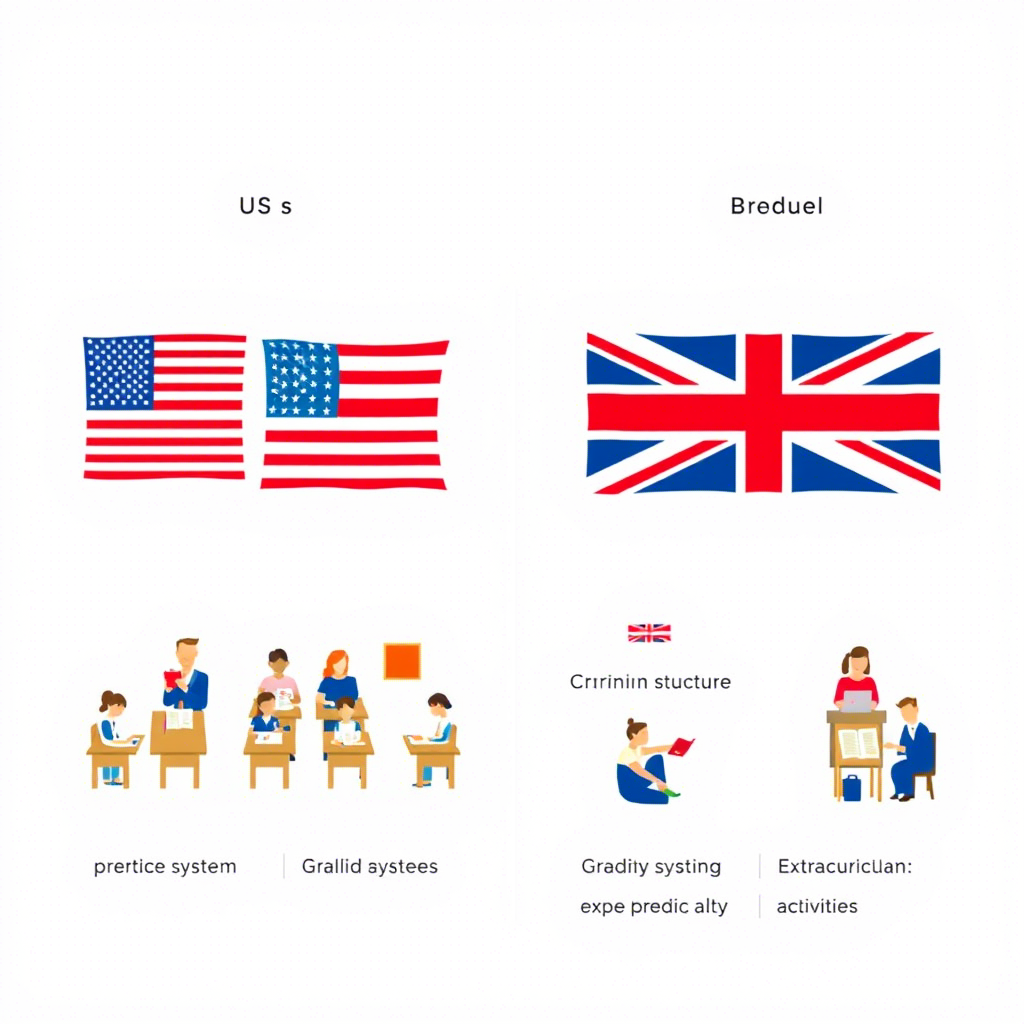Education is a cornerstone of societal development, but how it’s delivered varies significantly across countries. For families relocating internationally, or educators seeking global insights, understanding the distinctions between national education systems is crucial. Among the most commonly compared are the United States (US) and the United Kingdom (UK). Though both are English-speaking and Western, their school systems differ in structure, curriculum, assessment methods, and educational philosophy.
This article explores how US and UK school systems differ, offering insights into key areas like grade levels, school structure, curriculum focus, exams, and higher education pathways. Whether you’re a parent, teacher, or student, this guide provides clarity on what to expect from each system.
1. School Structure and Grade Levels
US School System
- Pre-School/Kindergarten: Ages 3–5 (optional)
- Elementary School: Grades K–5 (ages 5–11)
- Middle School: Grades 6–8 (ages 11–14)
- High School: Grades 9–12 (ages 14–18)
UK School System
- Nursery/Foundation Stage: Ages 3–5 (optional)
- Primary School: Reception to Year 6 (ages 4–11)
- Secondary School: Year 7 to Year 11 (ages 11–16)
- Sixth Form/College: Year 12 and Year 13 (ages 16–18)
Key Differences:
- The UK uses “Years” while the US uses “Grades.”
- UK students complete GCSEs at age 16, after which they can leave school or proceed to sixth form for A-Levels, while US students remain in high school until 18.
2. Curriculum and Subjects
US Curriculum
- Varies by state (no national curriculum).
- Common subjects: Math, English, Science, Social Studies, Physical Education.
- Emphasis on broad knowledge through general education.
- Electives in arts, technology, languages, and vocational training.
UK Curriculum
- National Curriculum (in England, Wales, and Northern Ireland).
- Core subjects: English, Math, Science, History, Geography, Art, PE, and a foreign language.
- At GCSE and A-Level, students specialize by choosing subjects.
Key Differences:
- UK students start subject specialization earlier (age 14–16).
- US students study a broader range of subjects through high school.
3. Assessment and Grading Systems
US Grading System
- Letter grades: A (90–100), B (80–89), C (70–79), D (60–69), F (below 60)
- GPA (Grade Point Average) is used for college admissions.
- Standardized tests: SAT, ACT, AP Exams
UK Grading System
- GCSEs graded 9–1 (9 is highest, 4 is pass).
- A-Levels graded A to E*.
- Standardized assessments at the end of each Key Stage (SATs in primary, GCSEs at 16, A-Levels at 18).
Key Differences:
- The UK system is exam-heavy at specific stages (GCSEs and A-Levels).
- The US uses continuous assessment and GPA over time.
4. School Year and Holidays
US School Calendar
- Typically runs from late August/early September to May/June.
- Long summer break (~10–12 weeks).
- Shorter holiday breaks: Thanksgiving, Winter (Christmas), Spring.
UK School Calendar
- Runs from early September to late July.
- Divided into three terms: Autumn, Spring, and Summer.
- Includes half-term breaks and longer Christmas and Easter holidays.
Key Differences:
- The UK has more frequent, shorter breaks during the year.
- The US has a longer summer vacation.
5. Types of Schools and Funding
US School Types
- Public Schools (government-funded, free)
- Charter Schools (public but independently run)
- Private Schools (fee-paying)
- Homeschooling is legal and widespread
UK School Types
- State Schools (government-funded)
- Academies (state-funded but independently run)
- Grammar Schools (selective state schools)
- Independent Schools (private, fee-paying)
- Homeschooling is legal but less common than in the US
Key Differences:
- The US system allows greater local control, especially in public schools.
- The UK has selective schools (like grammar schools), which are less common in the US.
6. University Pathways and Entrance
US Higher Education
- Broad liberal arts education in the first two years.
- College admissions based on GPA, SAT/ACT, extracurriculars, essays.
- Students usually declare a major by the second year.
UK Higher Education
- Specialized focus from the beginning (e.g., law or medicine at age 18).
- Admissions based on A-Level results (or equivalent), UCAS application, and sometimes interviews/tests.
Key Differences:
- The UK system is more specialized, while the US system is more flexible.
- In the UK, students apply to study a specific subject, not just to a university.
7. School Culture and Extracurriculars
US School Culture
- Strong emphasis on sports, clubs, and school spirit.
- Homecoming, prom, and graduation ceremonies are major events.
- Students often participate in multiple extracurriculars.
UK School Culture
- Extracurriculars exist but are often less central.
- Uniforms are standard in most UK schools.
- Less focus on school-wide social events compared to the US.
Key Differences:
- US schools tend to emphasize the **”whole student experience.”
- UK schools are generally more formal and academically focused.
8. Teacher Qualifications and Classroom Environment
US Teachers
- Require a state teaching license.
- Bachelor’s degree in education or subject + teacher prep program.
- Ongoing professional development varies by state.
UK Teachers
- Require Qualified Teacher Status (QTS).
- Degree + Postgraduate Certificate in Education (PGCE) or teacher training program.
- Regular Ofsted inspections influence teaching quality.
Key Differences:
- UK schools face more government inspection and regulation (e.g., Ofsted).
- US schools have more variation by district and state.
Conclusion
The differences between the US and UK school systems go beyond terminology—they reflect distinct educational philosophies and cultural values. While the US system emphasizes breadth, flexibility, and holistic development, the UK system favors early specialization, structured exams, and academic rigor.


